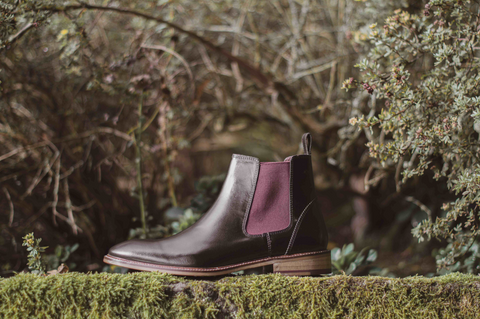The timeless Chelsea boot is a staple of any man or woman's wardrobe. Simple, smart and convenient for slipping on and off, this boot has been a british icon since the Victorian era. Perfect to pair with pretty much any context, the chelsea boot is arguably one of the best boots for men. We are going to tell you all about this boot's history, key features and how to style your boot for a range of different places and events.

A (Brief) History of the Chelsea Boot
The earliest form of the Chelsea boot was first designed in England in 1837 by no less than Queen Victoria's own cobbler, Joseph Sparkes Hall. The invention of vulcanised rubber, meant that he was able to introduce an elasticated side panel to the side of an ordinary boot. Originally called ‘paddock boots' they were patented in 1851 as the ’elastic ankle boots’ and were a favourite of both the Queen and her subjects, quickly becoming an essential part of country and equestrian life for generations to come.
The actual name ‘Chelsea boot’ came one hundred years later in the mid 1950s when the boot became a popular boot worn by the fashion forward ’Chelsea Set’. These were young designers, artists and socialites who frequented the Kings Road area in Chelsea in West London. This led to that style of boot becoming so associated with that area it became known as the Chelsea boot.

As the 60s rolled in along with the mod style of tailored suits and slim leg trousers, the chelsea boot became associated with bands such as The Beatles, The Rolling Stones and The Who. The Beatles popularised the addition of the cuban heel to the boot which was designed by shoemakers Anello & Davide. Other famous artists to choose the chelsea boot as their favourite footwear were, Bob Dylan, Andy Warhol and Jimi Hendrix.

What are the key features of the Chelsea Boot?
The Chelsea boot is characterised by the fact that it is a low heeled, ankle boot with no laces. Instead of fastenings, it has an elasticated panel, allowing the boot to be slipped on and off easily with the help of a handy pull tug on the back of the shoe. The elasticated panel is arguably the most recognisable feature of a Chelsea boot and can either match or compliment the overall colour of the boot. It is less fiddly than laces, saving the wearer valuable time and effort and creates a comfortable clean finish when the elastic gusset is hidden underneath a trouser leg.
The fact these boots are designed to cover the ankle which gives extra protection and support to wearers when they are out walking or riding in the countryside. The lower heel also helps ease of walking.

Another feature which creates the distinctive look of the chelsea boot is its construction. They are created using only two separate pieces of leather. These are the front or ‘vamp’ of the boot and the back or ‘quarters’ which are sewn together under the elastic panel on either side. This design not only makes the boots last longer as it is very durable, but also minimises the stitching to create a sophisticated, tidy look. This look is also accentuated by the plain round toes of the boot. This is why despite our love of broguing, our range of Hamilton Chelsea boots are unadorned, with the beautiful leather and suede instead creating that polished and paired back finish.
How to style your Chelsea Boot
The main selling point of the Chelsea boot is its versatility, so we have suggestions for how to pair your Chelsea boot best for whatever your environment.

Casual Wear
For informal events and weekends you can’t beat a suede Chelsea Boot like our Hamilton Boot in Suede. More casual than their leather alternative, suede is often thought of as tricker to maintain. However provided you keep them protected with a good suede protector and have a good suede brush to brush off any mud, your suede boots should be a great addition to your casual wardrobe.
For a sophisticated but urban casual look swap your trainers for a pair of black or bordo suede chelsea boots. Wear with dark jeans and a T-shirt for a look that will never go out of fashion.
For a more relaxed, layered country look, try wearing straight leg traditional blue jean over our tan suede chelsea boots. Team it with a classic overcoat and a plain tshirt or even a fine knit jumper if it is a bit chilly.

Office Wear
Thanks to their smart yet comfortable design there is a chelsea boot for the majority of work environments. Whether you are wearing a suit and tie or more laid back with jeans and a T-shirt, you can rock a chelsea boot and stand out for your style as well as your performance.
For a corporate work space pair polished leather with a smart suit. The colour will of course depend on your choice of suit, pair black Chelsea boots with a black or grey suit and a dark brown boot with navy. Fit and fold is key, your leg should finish just over the top of your boot and make sure there are no multiple folds or breaks at the front. Ensure the perfect fully throughout look by adding a matching belt.
If your office is a bit more casual Friday than ties and tailoring, you can’t go wrong with a pair of dark brown or black suede boots with jeans or smart-casual chino. The darker colour is very practical as it is easier to hide marks and scuffs from the day to day wear, so paler colours are best left for less frequent use.
A classic pairing of black jeans with a checked shirt and suede boots can take you straight from office to after work drinks.
